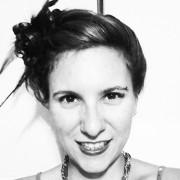Feminist Practices of Learning Together
Gülşah Aykaç and H. Işıl Uysal interviewed members of the feminist collective FAAC on their approach to learning through sharing and collaboration methods in feminist spatial practices.
H. Işıl Uysal: We have been following FAAC’s works through your website. In your field note titled “Counterplanning from the classroom,” you state that you as two art and two architecture historians [Ana María León, Tessa Paneth-Pollak, Martina Tanga, and Olga Touloumi] met by chance while having similar concerns about “exclusions from the standard curriculum and challenging established canons” (2017, p. 278). Accordingly, you formed a research group in 2013 to work on a cross-disciplinary art and architectural history course titled “Contested Spaces: Art, Architecture, and Politics.” The course revisits the histories with a feminist approach, questions the content of dominating canonical narratives. Followingly in 2016, you started testing this cross-disciplinary and collective syllabus in different universities [Bard College, Michigan State University, and the University of Michigan] by establishing collaboration among students from your separate classrooms. The course, “Contested Spaces,” has become a field to move in and through. As we followed in 2018, the collaborative expanded FAAC with a workshop titled “FAAC Your Syllabus!” in which you wrote a manifesto drawing an intersectional feminist frame for artists and architects. The manifesto was published in the Harvard Design Magazine in the same year. Finally, you presented “Contested Spaces” at the panel Expanding the Canon: Curatorial and Art Historical Activism in 2020.
Your website is a platform, a virtual place where we could meet with you and where we have been following your work. We can see that you continue as an active collaborative. Our first question is about invisible news from FAAC. Could you inform us about your journey after writing the manifesto in 2018? What are your experiences that are not visible on the website until today?
Olga Touloumi: That was a great summary of our work, thank you.
Martina Tanga: I think it is interesting what I know from the internal experience and what you see from the outside and the platform of the website is this interstitial space. I guess I never just looked from outside in the way you’ve looked; it is just quite fascinating. I want to speak sort of more personally, the group has transformations, there have been moments of very strong active work, and then we all have separate trajectories as well. So it has been an elastic coming together and disbanding. How I see it is FAAC is the work that needs to get done, it is not made up necessarily by the same people. The identity of FAAC is the production of this labour. Therefore, anyone that does the work is a FAAC member.
Olga Touloumi: Martina, that is an amazing way of describing FAAC. When we started the group, we were Ph.D. students in the job market. We identified a problem with the way art and architectural history survey course were taught. This problem brought us together. But as we were working together and experimenting with teaching, the collaboration changed, as well as the questions we asked. We went through a phase of intense work among the initial members, but we also felt a desire to expand. At the present moment, we are building up the group by building our references together. We read.
Rebecca Choi: I came later, it was in 2018 when we started to write the manifesto. And I think something that isn't shown on the website is the degree of sharing that happens. My entry point to FAAC was sharing literature, sharing books, and sharing ideas. And that was like mind blowing for me.
Emma J Cheatle: I was going to say something similar, because myself and Catalina also joined in 2018. I think what struck me when we first started to do some work with the group was how much we created. The collaboration itself could produce materials, ideas that we wouldn't be able to produce in smaller groups or as individuals. That was really kind of enlightening and fascinating. And I think hierarchies often might get built up in a group and direction gets made by those who are more empowered. What is really unique about being a part of FAAC is that there is kind of an equality and attention to each other’s points of view. And collaboration is built upon this attention, mutual respect and listening. Therefore, in the manifesto, it is impossible to see who wrote which pieces, whose ideas were whose.
Catalina Mejía Moreno: I think one of the wonderful things and less visible about the group is that we have a general interest in sharing, and also an interest in finding a safe place that we don't usually have in other institutions. There was some common interest that we were discussing, and some common questions we were raising. We were almost speaking the same language; but what makes it such an empowering and special group is that we also find each other’s support that we don't usually find elsewhere.
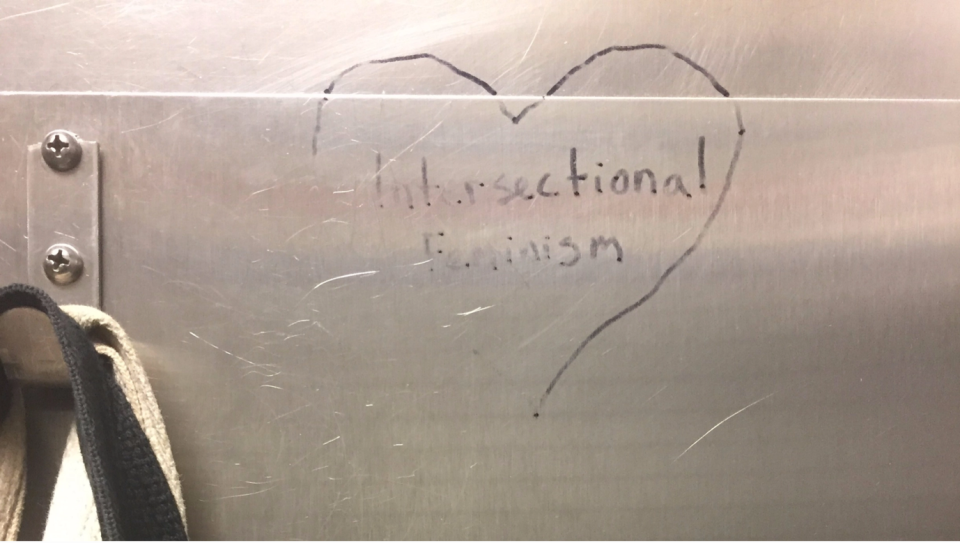
Gülşah Aykaç: What you’ve described about FAAC is really influential. Our second question is about your methodologies or the ways of collaboration. We were excited to see the record of the collective manifesto writing process. What are the tools, mediums, resources, and methodologies that the collaborative uses and follows in terms of sharing and discussing? How do the methodologies reveal and issues of discussion arise? What have been the ways of working together and sharing in terms of being a collective?
Emma J Cheatle: Shall I talk about the [2018] workshop then? There was a call for collaboration across the US. At that point, FAAC was composed of four members, and there was a desire to expand, not necessarily the group, but the kind of work that could be done. The workshop was around a table, it was about equality of being seated around the same table. We started by sharing the literature that was important to us, and we discussed why those references were important and compiled a reading list of different feminists. We divided into groups and started to think about syllabuses and curriculums. [On the second day] we set up a Google Doc and wrote [the manifesto] straight into the shared document in four groups, and that was going to be the four parts of the manifesto, then we switched around, shifting around the groups. Olga filmed the document growing. There was a creative process of bringing together the ideas with dialog and conversation. I learned a lot from those strong methodologies and used them later.
Rebecca Choi: In terms of methodology, what I took away from the collaboration is a really the practice of slowing down, for taking care and questioning. When we came together, we all asked ourselves what does this word “collaborate” mean? We went through such a long list of words that begin with: -co, the -co part was so instrumental. Words like collaborate, conspire, collude, collaboration were discussed. We were not just doing work, but working in parts, and a lot of the collaborative work was not about putting forward ideas, but about asking the questions. The approach was slow, intentionally slow. And that seems to be a key part of the collaborative method that we all shared.
Catalina Mejía Moreno: I want to add to that, as what I found really as key during the workshop and during the sessions we had afterwards was the openness and the generosity of everyone participating. I think that it was really beautiful to see that everyone brought and shared their syllabus, a work that requires so much work, and so much intellectual input. Everyone was sharing them and listening to each other very openly. Those practices of caring characterize the group, and are still very present in our conversations.
Charlotte Kent: I also came to the group in 2018 with the workshop, exhausted by the neoliberal outcomes model of an intellectual life where everything is kind of predetermined and you produce what has been said for you to produce. For me those two days of the workshop was a place where I developed a lot of trust. We were producing together, but it was very uncomfortable for me at the same time. Because I wasn't often sure what we were doing. That is not something that we do, culturally in the academy these days. So getting myself to become comfortable with this was one of the major shifts for me. The institution demands of scholarship mean that I am required to constantly proceed to the next thing, and it was actually amazing to be in a place where I didn’t know what would happen next, how the manifesto we co-wrote would evolve, and so forth. There is a way of opening up into the learning of that experience can be really significant.
Martina Tanga: Another remark about trust, I think that is really important. The collaborators have had babies born, individuals had to step away for a period of time because they had other projects to do, and I think there is sincere and very fundamental trust that everyone is there in FAAC because they want to be. And they will give what they can give at that moment. Sometimes, it is a little bit more; sometimes, it is a little less radical acceptance of what you can give. I always felt there is no judgment on that, and it is really important to build the glue that holds it together.
Olga Touloumi: It is interesting to hear everybody describing our methods. 2018 was a very important moment of introspection and expansion. Speaking for myself here, I admit that I was not completely aware of the methods we were employing, but I knew that we were choosing our tools out of a desire to work together differently; to resist patriarchy, single authorship. We experimented a lot. Some tools worked for us, helping us curve space for feminist intersectional thought, and some did not. For example, I have been very adamant about foregrounding the collective and not individuals, thinking of the group as an ecology. I am not so sure about my conviction nowadays. Insisting on the collective identity can be oppressive and even feel as erasure. We have been slowing down, as Rebecca noted, taking on slow reading, slow writing with care for the work and people involved. Emma talked about the synthesis of voices that happens by shuffling roles and people, which, in my experience, suspends group hierarchies from setting in. We also scale group work. For example, in 2018, we broke up the initial group of sixteen participants into four groups of four writers for the initial draft and then edited the text in two groups of eight people. And we try to cite our sources, influences, and inspirations in our teaching documents and essays, a sustained political engagement with citations that I learned from our former collaborator and founding member Ana María León. In terms of theoretical method, when we founded the group, we were inspired by Kimberlé Crenshaw’s intersectionality, and we hope to deepen our intersectional practices.
Charlotte Kent: Just to add to the different roles the project required...thinking not only in words but design became important, because as it turned out the manifesto required design elements to achieve what we wanted. That was interesting too as a method of doing.
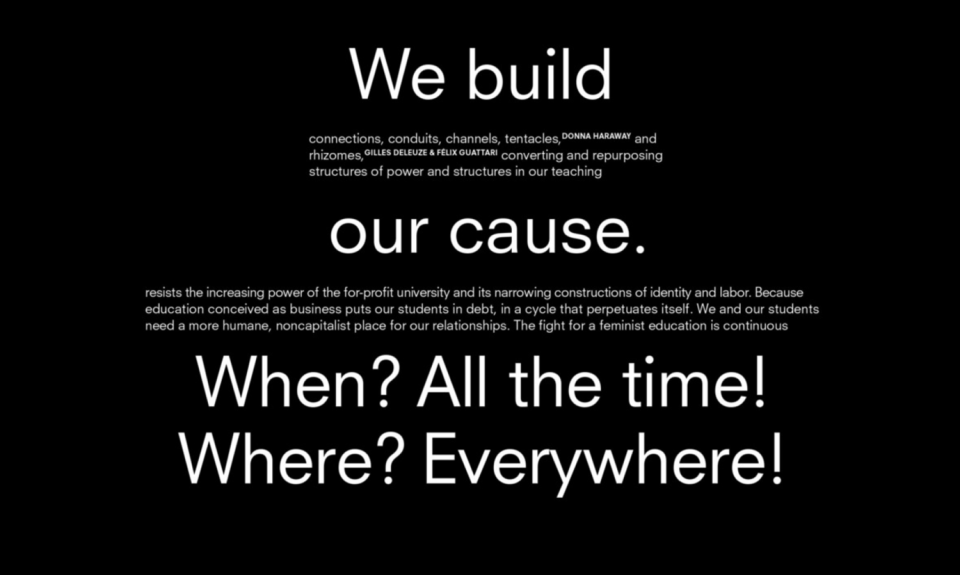
H. Işıl Uysal: While we were reading the manifesto, the text appeared to us as developing over by being critical about dichotomies of gender identities, power relations, and hierarchies while stressing oppositions and differences. On the other hand, there are also a number of references that pass through dualities, such as Haraway’s “cyborg” and Deleuze & Guattari’s “rhizomatics” which are also involved in feminist discussions. In which contexts do your current theoretical discussions and readings take place? Depending on the different feminist paths, methodologies, and pedagogies, we would like to know your possibly differentiating positions and what you are discussing within FAAC currently.
Catalina Mejía Moreno: Searching for common languages brought us again together under the proposition of being FAAC workers after the workshop. At the moment we find reading together, quietly and loudly, individually and together, as a good possibility to start thinking about that question, as well as practice of self-care and care to/for others.
Charlotte Kent: One of the meetings was done around fiction. Most of my dissertation was about how the history of art and art itself can also be informed by other types of texts, that are personal, that are expressive, that are poetic. So, the group is open to many ways of critical thinking, like reading fiction. The way of choosing books also comes from individual interests, not exclusively from dense theoretical books.
Emma J Cheatle: When we first met in 2018, the reading list was very interesting to me, because it created an almost unspoken conversation between the European tradition of feminism and the North American tradition of feminism. The reading group now is an explicit attempt to break out of that conversation between predominantly white feminists, and think intersectionally and more globally as well. Also, the fiction enabled us to do that, to break out of this “high theory” attributed to particular writers. Fiction is a really good way of entering into another world, another way of critical thinking, a way of reading between the lines.
Olga Touloumi: This is also an attempt to broaden what the archive is or consists of. It is not only formalised texts, letters and reports. The archive can include fiction, oral history, nonprofessionals, even objects.
Rebecca Choi: I just pulled up the shared bibliography we created back in 2018. And there is Mary Beard The Public Voice of Women, Combahee River Collective Statement, Alyson Escalante’s Gender Nihilism and Anti-Manifesto, Donna Haraway’s Cyborg Manifesto, and the list just goes on and on, there are three pages. This kind of working bibliography might have been the framework that the founding members of FAAC put forward–opening up a culture of sharing readings, as a kind of discussion point or entry point. A kind of shared bookshelf is there. But I think our thinking of collaborative work is about transbordering, trans-thinking, and transdisciplinarity. Reading more Black feminist thinking as a way to think through those concepts, for me even the term trans, is special and helpful.
H. Işıl Uysal: After that question, we want to shift to the specific areas of art and architecture. In the field note titled Counterplanning from the Classroom, you are referring to Mierle Laderman Ukeles’s Manifesto for Maintenance Art 1969. We also would like to know your interest in other works of art and architecture / arts and architectures in the context of feminist perspectives?
Olga Touloumi: I think it is a big question. Ukeles’s work as an artist-in-residence at the New York Department of Sanitation foregrounds maintenance labor, bringing in the question of class. But also Kara Walker’s A Subtlety (2014) was important for opening a conversation on racism and colonialism, and Martha Rosler’s Semiotics of the Kitchen (1975) helped us discuss reproductive labor.
Emma J Cheatle: I think it is maybe some certain people’s processes; it is more process-driven than output driven. I want to offer Agnès Varda’s films. I use them quite often in my teaching. And the films and installations of Trinh T. Minh-ha, the 1981 Re:assemblage, for example. These sort of work around ethnography –anti-ethnography actually as Minh-ha is critical of the origins of ethnography – using observation, and feminist documentary or anti-documentary as Minh-ha calls it.
Martina Tanga: My independent work sort of seeps in and out of FAAC; it is very intertwined for me. So to offer up, I have been thinking a lot about the painter Loïs Mailou Jones. I have been thinking a lot about the politics of looking to the point of origin and Pan-Africanism. I want to say that the fluidity of all of these things, in my mind, is very generative.
Olga Touloumi: This is a question that I think about quite often: what works influence me, and what do they influence in my teaching or research. But fundamentally this is a difficult question to answer in a way that is productive. By offering some names you leave out others. I don't trust my first instincts to answer because my first instinct often goes to a very white place. I am trying to fight that back as much as I can.
Catalina Mejia Moreno: I find my work is in dialogue with FAAC’s. I also struggle with naming, because as Olga has said it, it excludes. However, I would like to mention some artists that I have been recently looking at whose art-work are forms of anti-racist and environmental activism: The work of Colombian artists Carolina Caycedo and Felipe Arturo, and the work of South African artist Berni Searle...
H. Işıl Uysal: Seeing the hesitation is also very important for me, thank you.
Susanō Surface: I have no difficulty answering this question! Queer the Land here in Seattle has worked for several years to purchase a 12-bedroom house. They are transforming it into a place specifically where Black, Indigenous, and People of Color who are queer and trans can live. Wa Na Wari is located in co-founder Inye Wokoma’s family home in Seattle’s historically redlined Central District. He wanted to ensure that the building could stay in Black community rather than being seized by predatory developers or gentrifiers. In addition to providing housing for a community elder it also creates a more open cultural space. M. Carmen Lane, an artist, healer, educator, and writer based in Cleveland, has taught me a great deal through her writing and projects. I am fortunate to work in places where I can support artists working in these areas. One example is Brings the Medicine Sundial by Kimberly Corinne Deriana, which was commissioned for the yəhaw̓ exhibition at ARTS at King Street Station. This was her first public art commission, and she created an inclusive Indigenous process to design and fabricate the sculpture. As part of the Facilities and Equitable Development committee at the Seattle Office of Arts & Culture, we hold an annual event called Square Feet Seattle. We bring people together in a room - with an emphasis on people of color - and, ask them what we should do with a portion of the office’s Cultural Space budget. In 2018, they came with the idea of a tiny cultural space, and this participatory process resulted in a small library called Estelita’s Library that was finished in 2020. It holds a collection of Black Panther Party newspapers - one of the largest collections in the county. It took a disused, awkwardly located vacant lot and turned it into a place for the community living nearby. Embedded consent and communication are the basis of my working definition of design approaches aligned with feminism. It’s asking people what is needed, centering them, then working flexibly and responsively rather than a top-down decision-making structure.

Gülşah Aykaç: Before concluding, we would like to ask about our current condition today, online education. How did remote education due to the ongoing pandemic affect art and architectural design studios and other classes depending on your experiences?
Susanō Surface: I am both a student and a professor right now. I finishing up the Certificate in Commercial Real Estate at University of Washington, and I teach the BFA Professional Practice course for graduating visual arts majors at Cornish College of the Arts. COVID and remote education are clearly affecting my students in the sense that they are so stressed out and distracted. They, and their loved ones, are getting sick, struggling, worrying about money. It’s harder to use the school facilities. They are worried about what kind of jobs they can get when they graduate. Personally, I’m finding that I quite enjoy the online format as a learner. I love attending lectures without commuting, and the ability to turn off the camera to recline or move my body so I’m comfortable. Online learning and teaching meet my access needs in the specific ways I’m chronically ill and neurotypical, but I know that others find it an access barrier.
Emma J Cheatle: I can talk about the UK experience. We’ve been online since March 2020, so for a really really long time, apart from one ease of the lockdown between September and the beginning of December last year. We’re just going back to some face-to-face (in person) teaching now. It has been a lot of work for us, our workloads skyrocketed going online; the preparing of materials has been really hard work. And we’ve been badly affected by staff sickness and absences; and so some colleagues had to take on more and more workload. Let’s say overall, it is a quite negative experience for us as staff. For the students: lots of students are very isolated, there have been access issues where the students don’t have the equipment or the background to help them with the resilience that they need to get through this period. The other very big downside is that we lack social interaction as staff and students. Students find themselves on their own a lot more. As staff, it is also difficult to smooth things over through informal chats, everything is formalized by formal online meetings. On the other hand, there are some really positive things that have come out in terms of being able to easily communicate with colleagues all over the world. I suppose what we miss in our local institution we gain from a kind of global perspective, but that comes with a sort of weird sense of a very different kind of sociability for me where you don’t have those kinds of informal conversations with people.
Catalina Mejía Moreno: My experience is pretty similar. I teach first year students in undergraduate and master programmes. So I welcome the groups of students who are arriving at the University through an online teaching platform. I believe in the first year you really need that face-to-face and collegiality, and to build trust while relating. But on the other hand, I have realised how Covid tests all your resilience, and you end up being quite flexible in your mode of teaching. You find ways to respond to your student needs, you change the content from one session to the other, or use more interactive platforms which weren't necessarily used before. It has been a test for all of us in and in different ways. Students coming from all over the world to the UK have been mostly asked to be on campus, so they are quite isolated. And as staff who cares we need to give pastoral care and any kind of care, but digitally. It poses a special challenge for us.
Olga Touloumi: At Bard we have been teaching in-person, with only a few sessions of online teaching. The masks make communicating emotion extremely hard. I often found myself exaggerating emotional expressions to cut across the boundary that the mask presents. But Covid also changed the architecture of the classroom. Speaking up and building trust in the Covid classroom, where everybody faces in one direction and with masks on, is extremely difficult. Students cannot see their peers’ expressions and they feel judged. The setting also reinforces the authority of the professor. Being in the Covid classroom is stressful. On the other hand, online some students cannot retain attention, especially students with ADHD.
Martina Tanga: I can talk a little bit about the museum context. Actually, it needs to be a whole re-understanding of the tool. Museums have scrambled to generate, in the absence of in-person gallery experiences, at least all of the museums in the US, so much online content. And there was a lot of content, hours and hours of digital content, of programs lasting a very long time like gallery tours, talks, and symposia. Not just ADHD individuals, but all of us have had our attention threshold tested by this digital performance. Not enough energy has gone into figuring out how to make programming effective, translating the in-person experiences into the digital. Additionally, understanding the barriers to access online content is really real.
Susanō Surface: Emergency online school is not the same as intentional online pedagogy and methodology. That obsession with urgency, and this impending sense of things needing to be figured out – that is simply off the table. Imagine: what if colleges didn’t need to be terrified of shutting down forever if they need to close for a year? What if people had universal basic income and did not need to be terrified of losing their jobs and becoming unable to sustain themselves? That is not strictly an academic thing, it is a deeper structural issue impacting all workers; for that matter, all people. For many in my community, these problems existed long before COVID - many never had living-wage jobs to lose. My optimism is that we can adapt things that are working for this pandemic, and build upon that resilience and flexibility in our teaching and learning.
Gülşah Aykaç: Those perspectives really extend the issue of remote teaching with multiple dimensions. In Turkey, we also have particular difficulties from the side of the students. It is really hard to empower the individualities of students in the design studio while they are living in their family-house since their house is where they produce and join the studio. We have observed that it is really important to get out of a house and come to the university place, or move to another city for the university.
We would like to conclude with a final question. What are the implications of events, workshops, meetings, collaborative courses you’ve experienced up until now? Could you inform us about future plans of the collaborative?
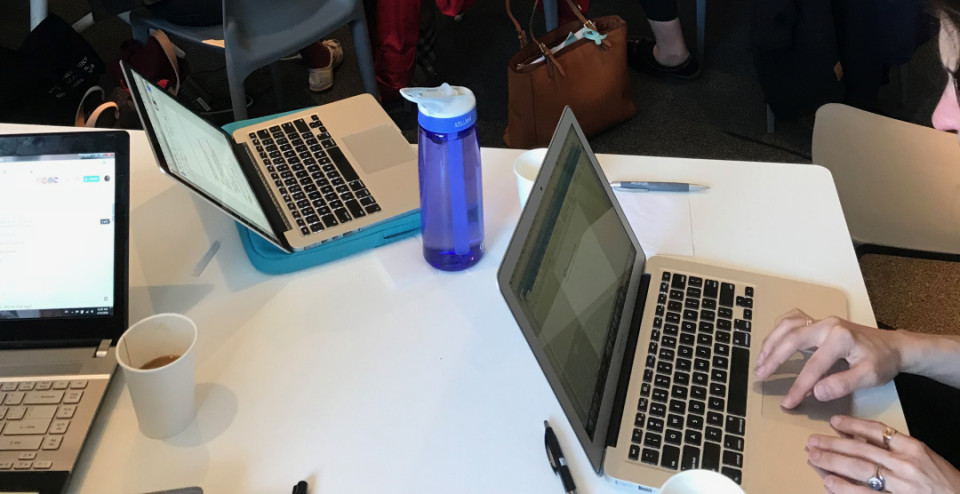
Olga Touloumi: Working together as a collaborative -- reading together, writing together, talking together -- shapes my thinking, my teaching, even my research. I appreciate being pushed on my own assumptions. That’s how I learn. About our future plans, I cannot say much. We are using this moment of slowness to reflect and grow. When the pandemic and the Black Lives Matter movement happened this summer, my initial reaction was a desire to address both immediately. But the fight for social justice lasts longer than any one event. We need endurance for structural change.
Martina Tanga: I see this time as one of internal growth and caretaking; you know we are practicing care for each other, to go back to the extreme pressures we are facing on the outside world, professional lives and expectations, either academia or museum job. We are entering a nurturing phase. I think it is really important for the work we want to do. So it is not just producing and output, but of growing deeper roots, nourishing those roots. I think taking the time to do that intentionally is very important.
Susanō Surface: I am grateful to have this community of people that I deeply respect and trust. I love that we are not always taking action. Collective caretaking sometimes looks like giving each other space to do what we need to do elsewhere. I am grateful that the group doesn't enforce visible productivity, and we’re adaptive to what’s needed at the time.
Catalina Mejía Moreno: Being a part of this collective care-taking moment also reminds us of our own self-care. In our meetings, we are at this precious moment of being outside our daily, intense routines. It is a privilege being in this collaborative. And also thank you for bridging us, asking us these questions collaboratively.
H. Işıl Uysal + Gülşah Aykaç: It is really inspiring how togetherness could be transformative in your individual experiences and works. Thank you for your time and all your responses.
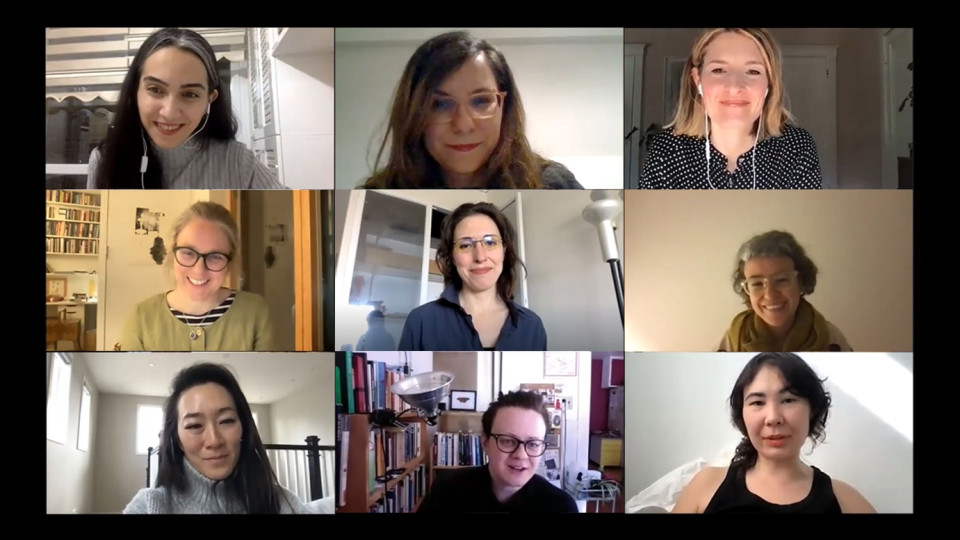
Related Content:
-
One Little Bourgeois Problem: Wanting Very Much but Being Unable to Preserve
More concerned with the practical area than the theoretical area, preservation has the potential to touch the society a little more.
 01.06.2021
01.06.2021




